If your horse drags you to the pasture and bolts away from you, kicking up his heels and tearing the lead rope out of your hand before you even have a chance to take the halter off, you’re asking for trouble. It’s not a matter of if you’ll get hurt, but just when.
Dealing with horses that have pasture problems, whether those problems are associated with leading to the pasture or bolting or kicking out once in the pasture, all boil down to the same culprits—your horse doesn’t respect you and you don’t have control of his feet. How severe your horse’s problem is will dictate how you correct him.
Almost all horses that bolt away in the pasture are a product of their handler’s negligence. Think about how you turn your horse out. Most people lead their horse out to the pasture and once they reach the gate, they immediately take the halter off and let the horse walk away from them. It doesn’t take long before the horse anticipates being turned out to eat grass and be with his buddies, so when the person starts taking the halter off, he turns his head away, eyeing up his next meal or watching his buddies. Then, the next time he’s led to the pasture, he starts walking off before the person even has the halter off his head. And it just builds from there. Before you know it, the horse is dragging you to the pasture while you desperately try to hold onto the lead rope.
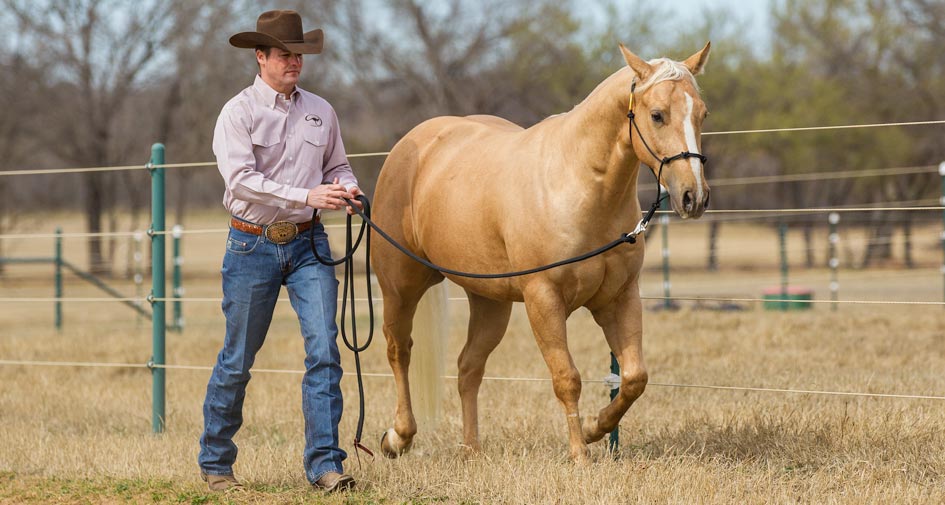
Horses that are pushy or race ahead while being led are dangerous.
Horses are great at predicting our moves. They know what we’re going to do before we do it. The first time your horse turns away from you and the lead rope slips through your hand, you plant a seed in his mind. “Ah,” he says, “that’s interesting. I turned my head and she didn’t do anything about it. I wonder what would happen if I just started walking off? I bet I’d get to join my friends even sooner.” Once the seed is planted and you let him do the same thing again, a habit starts to form. The longer you let the habit go on for, the harder it is to correct.
My first suggestion to people with this problem is to start the Method from the beginning and work your way through the Fundamentals Series—not skipping a step. Your horse’s behavior is a clear sign that you have no control of his feet. Once you get control of his feet and prove to him that you’re the leader in your relationship, your problem will more than likely disappear. Incorporating the fixes I’m about to explain will teach the horse that just because he’s in the pasture, it doesn’t mean you can’t control his feet.
Getting from Point A to Point B
If your horse pushes into you, rears or rushes past you as you lead him to the pasture, turn a negative into a positive. Rather than just leading him to the pasture and turning him free, prove to him that you can move his feet whenever and wherever you want. On the way to the pasture, practice the C-Pattern exercise, sidepass him, back him up, etc., anything you can think of to move his feet around you. By the time you get to the pasture, he should be focused on you and moving his feet. If he isn’t responding well when you reach the pasture, turn around and work your way back to the barn and then back down to the pasture again.
Once you reach the pasture, instead of taking the horse through the gate and immediately turning him loose, remind him that you can control his feet in the pasture. A great exercise to practice is the Sending Exercise in and out of the pasture gate. Start by making the opening 6 to 8 feet wide and send the horse back and forth through it. When he’s going through that distance well, then challenge him more by decreasing the distance.

Instead of just leading your horse to the pasture, teach him something along the way. You can back him up, do the C-Pattern or sidepass him.
Sometimes horses get frightened of going through gates because they’re tight, narrow spaces and make them feel claustrophobic. As prey animals, horses hate being in narrow spaces that make them feel trapped. This can be especially true if your horse has been “bitten” by the gate—the gate hit him while he was being led through it. The Sending Exercise will prove to him that you can control his feet going in and out of the gate and he has nothing to worry about. Start with the gate wide open, and as the horse becomes more confident, make the gap smaller until you can send him through a 4-foot space. It may take quite a few repetitions before he relaxes and goes through the opening calmly. Ideally, you want him to quietly walk through the gap, and then yield his hindquarters with a “Yes, Sir!” type of attitude.
When you can send the horse through the gate with ease, then take him inside the pasture, shut the gate and practice sending him back and forth in front of the closed gate. You’re just reinforcing to him that even though he’s in the pasture and the gate is closed, it doesn’t mean he can tune you out.
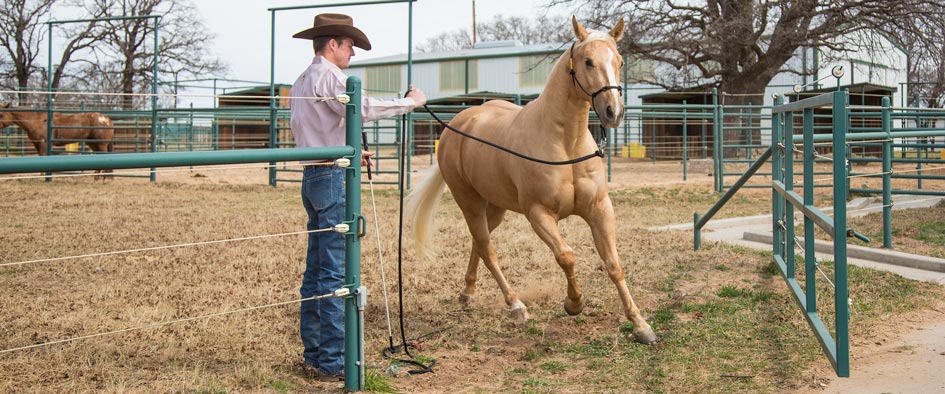

When you reach the pasture, send the horse back and forth through the gate. Initially, keep the gap wide to build the horse’s confidence. Gradually close the gap until you’re able to send him in between a 4-foot opening.
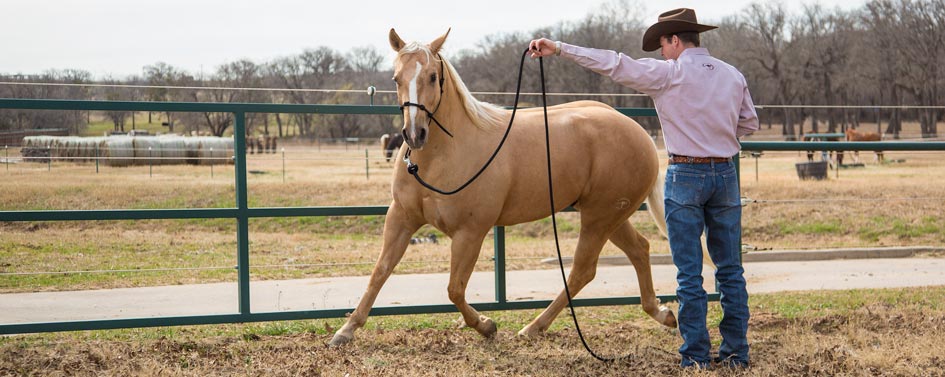
Prove to the horse that just because he’s in the pasture it doesn’t mean you can’t control his feet by sending him back and forth in front of the gate.
Two Eyes , Please
With a horse that likes to turn and bolt away from you as soon as you take the halter off, one of the best things you can do with him in the pasture is practice Yield the Hindquarters Stage Two to get him hooked on giving you two eyes. Anytime you’re around your horse, two eyes are always better than two heels. As long as the horse is looking at you with two eyes, he can’t bolt or kick out at you. Remember, with horses, it’s two eyes for attention and respect and two heels for disrespect. Practice the exercise until as soon as you even lean forward and look at the horse’s hindquarters with active body language, he immediately yields his hindquarters and looks at you with two eyes.
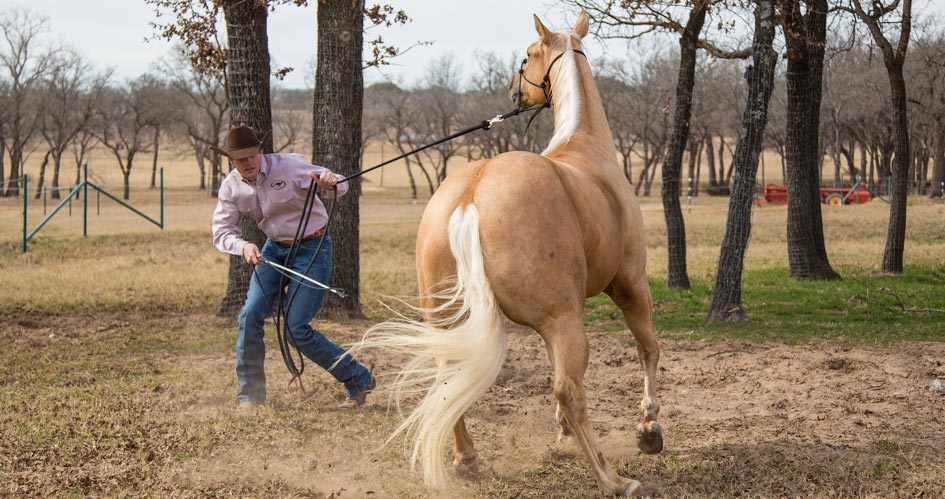
Two eyes are always better than two heels. With a horse that bolts once he’s in the pasture, practice yielding his hindquarters.
Once you have the horse hooked on giving you two eyes, then you can test him to see what he’ll do when you take the halter off. Act like you’re going to take the halter off—stand up by his head and fiddle around with the knot. Then take a step forward as if you’re going to walk away, but immediately turn around and look at the horse’s hindquarters to get two eyes. If he doesn’t immediately swing his hindquarters away from you and face you with two eyes, spank his butt with the Handy Stick or the end of the lead rope. Getting two eyes is the complete opposite of you taking the halter off and the horse spinning away, kicking out and running off. Practice that until the horse remains standing still when you pretend to take the halter off and he immediately gives you two eyes as soon as you turn and look at his hindquarters.
Then up the challenge even more. Take the halter off and tie it around his neck so that you still have some control of him. Because the halter isn’t on his head, the horse will think he’s free to do what he wants. You’re going to prove to him that isn’t the case. Take a step forward as if you were going to walk away from him just like before. Then immediately turn around and look at his hindquarters to get two eyes. If he doesn’t face you, spank his butt with the stick or the end of the lead rope. You almost want him to get “butt shy” to where he doesn’t want to take his eyes off you. When he does face you with two eyes, be sure to reward him and rub his face. Make him feel comfortable for looking at you.
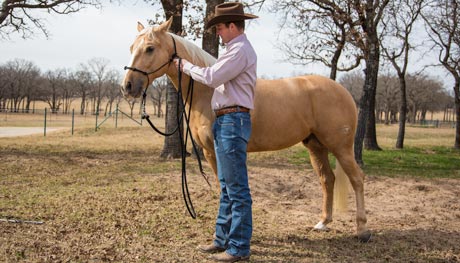
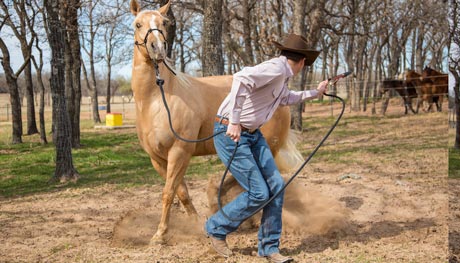
You can fool the horse into thinking he’s being turned loose by pretending to take the halter off him. Then step forward and turn around and yield his hindquarters.
Take the Halter off Safely
It’s a great habit to teach your horse to lower his head and then tip his head toward you when you’re haltering and unhaltering him. If his head is low and tipped toward you, it’s a submissive position and is the opposite of him looking off at the other horses and planning his run around the pasture. Ideally, when you take the halter off your horse, you want him to stay in position and keep two eyes on you as you walk away from him.
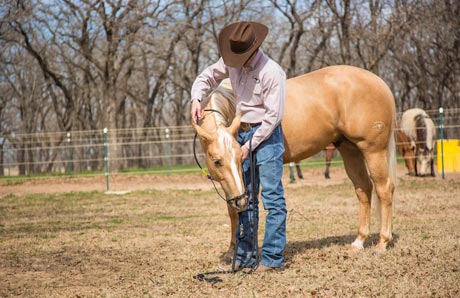
I teach all of my horses to lower their heads using the Intermediate groundwork exercise Touch and Rub: Poll. When the horse’s head is level with your belt, reach your right arm over his head and apply pressure to the right side of his face with your fingertips. As soon as he yields to the pressure by tipping his nose toward you, rub him in the same place you pressed. In the beginning, you can help him understand by pulling on the halter, or if the halter isn’t on, using the tail of the halter to apply pressure. If you practice doing this every time you halter and unhalter your horse, you will develop a positive habit. It won’t be long before the horse lowers his head and bends it toward you before you even ask him to.

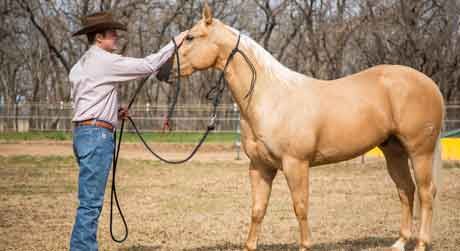
Practice the same technique with the halter tied around the horse’s neck. When he faces you with two eyes, be sure to rub him and make him feel comfortable for facing you.
Fool Him
The techniques I just described will work on the majority of horses. However, if your horse has been doing this for a while, it may require a more aggressive approach to fix him. If that’s the case, halter your horse like normal, and then put an extra halter, with no lead rope attached to it, on him. This will allow you to practice taking one halter off but you’ll still be able to control him.
When you take the extra halter off, the horse will anticipate being set free and will probably try to turn around, kick out and run off. As soon as he goes to leave, step back and pull hard on the rope to get two eyes. When I say pull hard, I mean pull hard. Act like you’re trying to pull his head off. You aren’t of course, but you get the idea of how aggressive I want you to be. If that sounds extreme, that’s because it is. You’re dealing with a very dangerous situation. Make no mistake about it; a thousand-pound animal can easily kill you with one kick.
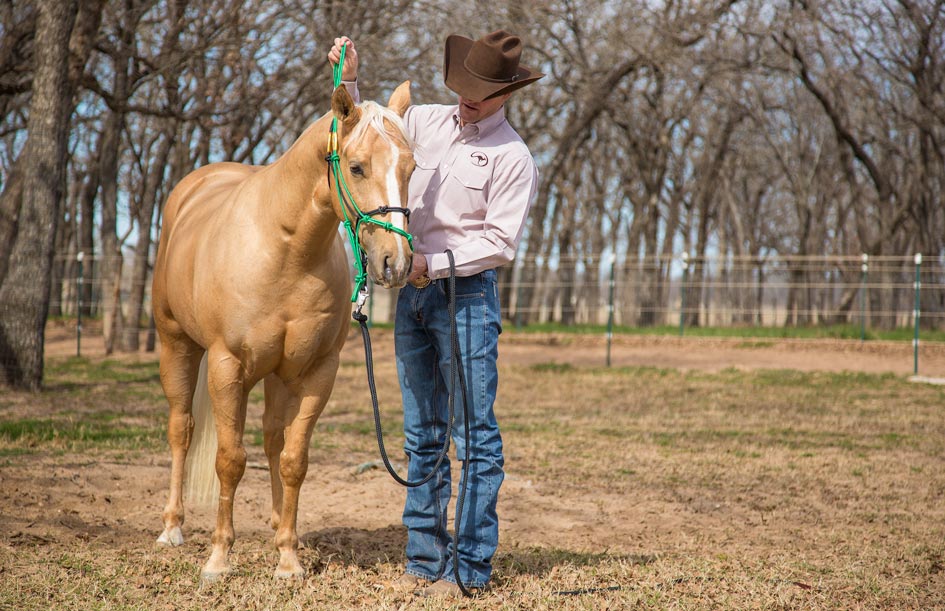
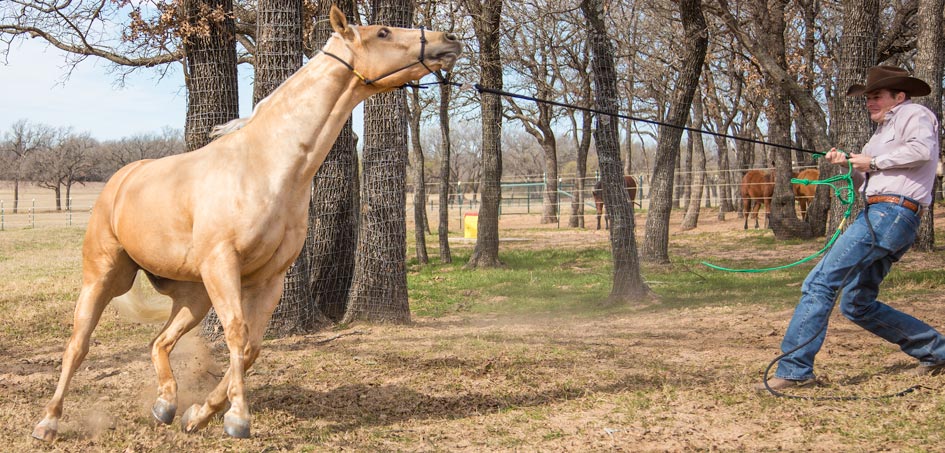
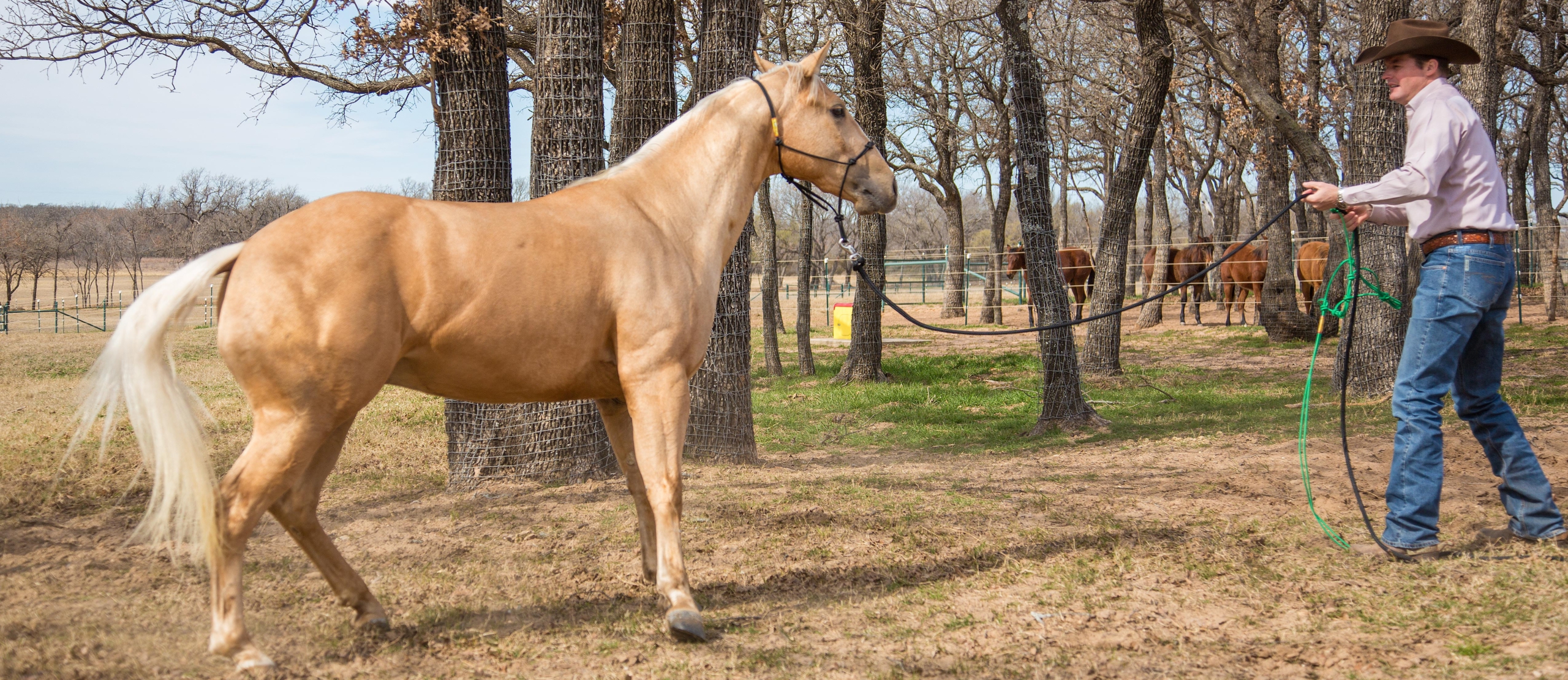
Practice taking an extra halter off the horse. If he tries to run away when he feels the halter coming off, immediately pull on the lead rope to get two eyes. As soon as the horse faces you, release the pressure.

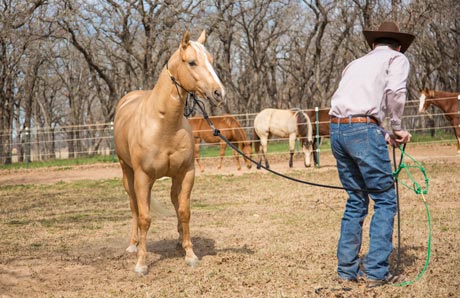
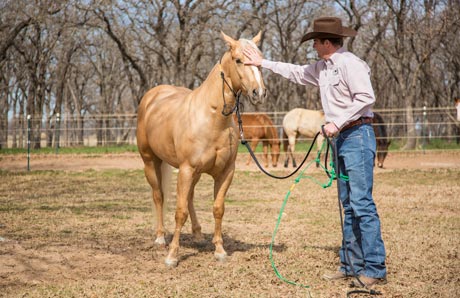
Fool the horse even more by tying the halter and lead rope around his neck. Then practice taking the extra halter off him (left). Then see if you can yield his hindquarters just like before, getting him to face you with two eyes (top right). When the horse yields his hindquarters and looks at you, rub him (bottom right).
Turnout Safety Tips
1. If you’re turning your horse out with other horses, get them away from the gate before leading your horse through it. People often suffer serious injuries turning horses out because they’re unaware of the herd dynamics of horses. When you throw your horse into a herd, the other horses will react, and if you’re not careful, you’ll get injured in the process. Horses aren’t looking to nail you, but they are big and strong, and as they interact with other horses, they can easily forget that you’re standing just a few feet away from them. That’s how you get run over or get kicked.
2. When you are ready to unhalter your horse, be at least 100 feet into the pasture, away from the gate and away from the fence, so you have room to move. You want to avoid getting pinned against the fence with nowhere to go, either by your horse or by other horses crowding him.
Practice taking the extra halter off the horse, and every time he goes to leave you, pull on the rope. As soon as he faces you with two eyes, release the pressure. Repeat that as many times as necessary, until eventually the horse remains standing still when you take the extra halter off. Think of the halter and lead rope as a backup plan— you want the horse to stand still when you take the extra halter off, but if he doesn’t, you have a way of controlling his feet and getting two eyes.
Then you can increase the challenge even more. Put the extra halter, without a lead rope attached, on the horse’s head. Tie the halter with the lead rope attached to the horse’s neck. Practice taking the halter on his head off. You’re basically doing the same thing as before, but you’re testing the horse more. When he feels nothing on his face, he’s likely to try to take off again, but you’ll have the halter around his neck to pull and get two eyes. Work on this step until you no longer need your backup plan so that the horse remains standing still when you take the halter off of him.
End the Session on Your Terms
When you’re ready to turn the horse loose, you want to be the one who walks away from the horse, not the other way around. That’s the complete opposite of you taking the halter off and him running away from you. If you let the horse walk away from you, you’re feeding his desire not to be around you. However, if you’re the one who walks away from him, you’re the one who ended the session. You don’t want the horse to run away, thinking he escaped you.
The key to fixing a horse with disrespectful behavior in the pasture is doing the groundwork exercises and getting control of his hindquarters. I guarantee if you practice the Fundamentals and are consistent about making sure the horse is using the thinking side of his brain when you’re turning him out, this problem will take care of itself. I recommend doing groundwork exercises to the pasture as well as in the pasture even if you don’t have a problem horse. Keeping the horse respectful and using the thinking side of his brain during pasture turn out is just good maintenance and will ensure a problem never gets started in the first place.
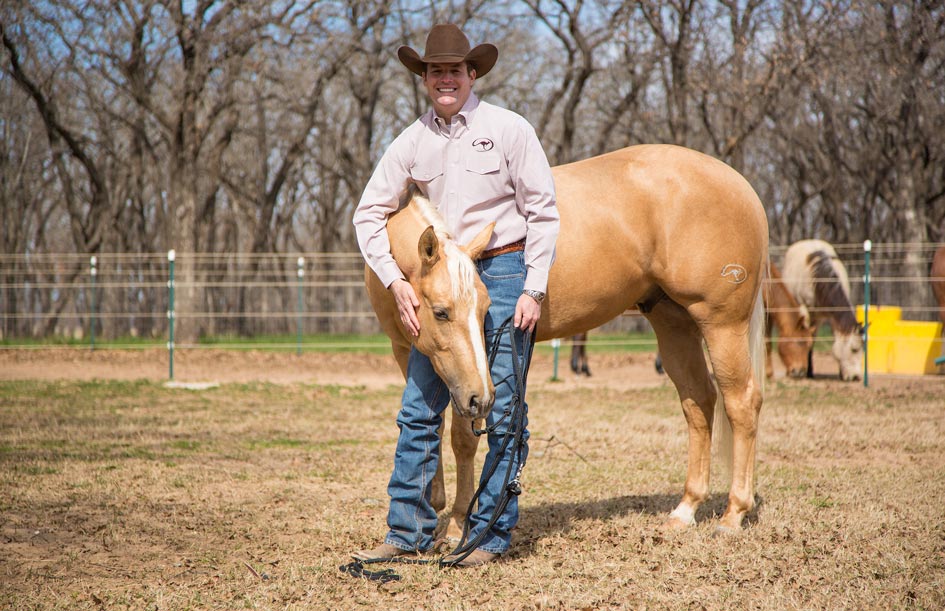
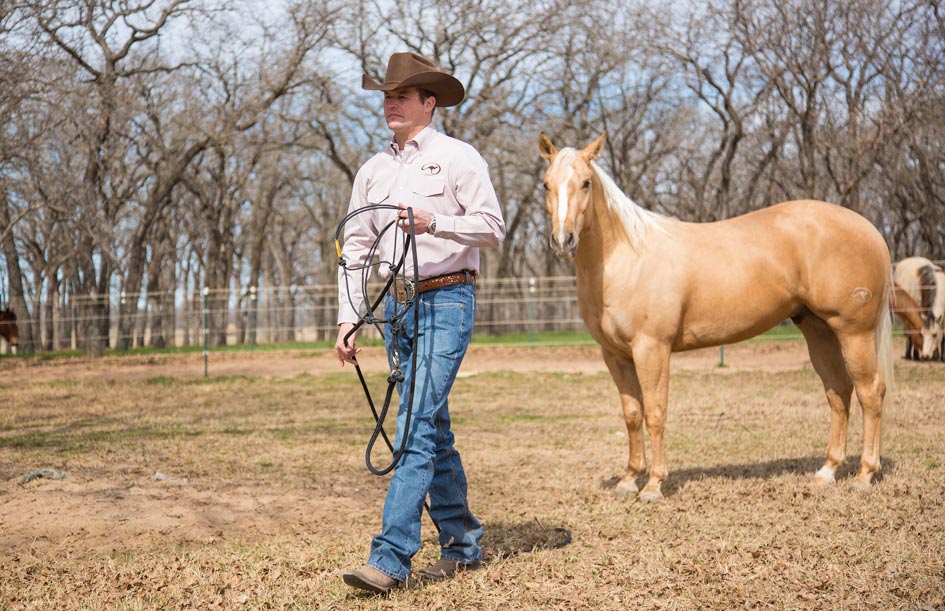
When you turn the horse out in the pasture, he should stand beside you calmly when you remove the halter and then wait for you to walk away from him.
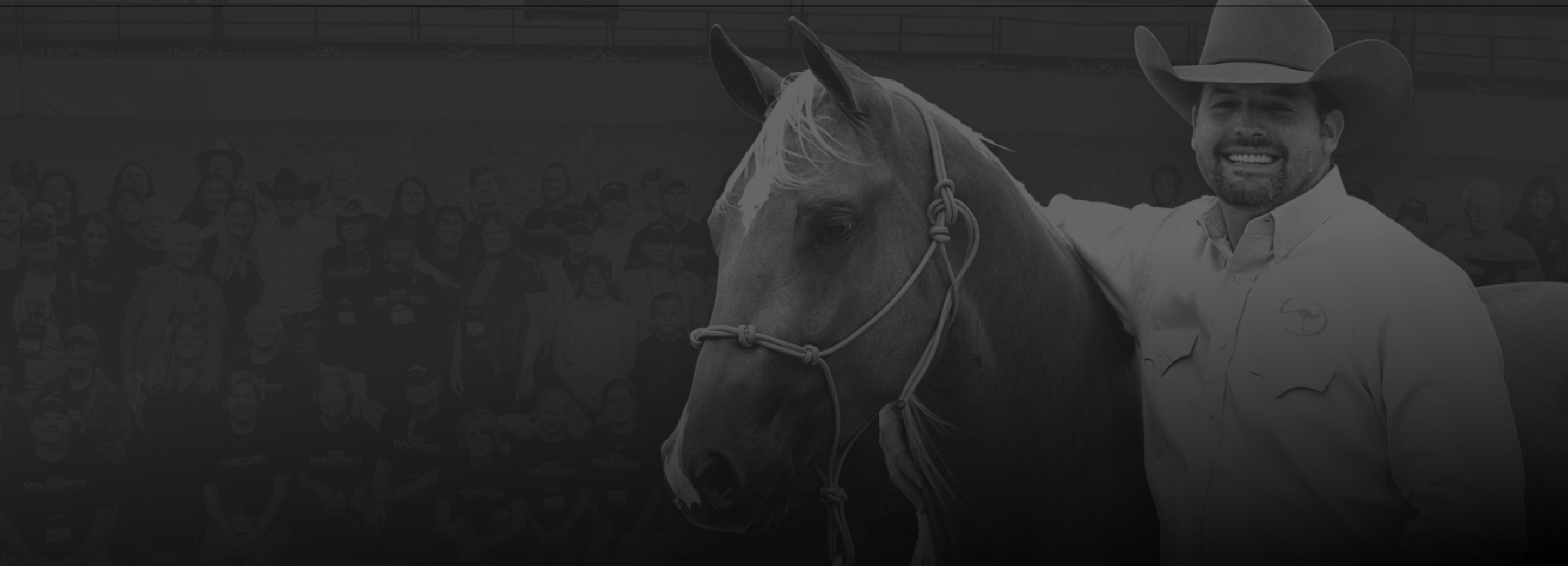
Want To Learn More? SIGN UP FOR OUR LOYALTY PROGRAM
Master your horsemanship training through Clinton’s step-by-step method videos by joining the No Worries Club today. Becoming a club member ensures you get VIP pricing on all of Clinton’s must-have training tools and resources. Plus, you’ll enjoy all the phenomenal benefits that come with club membership!



